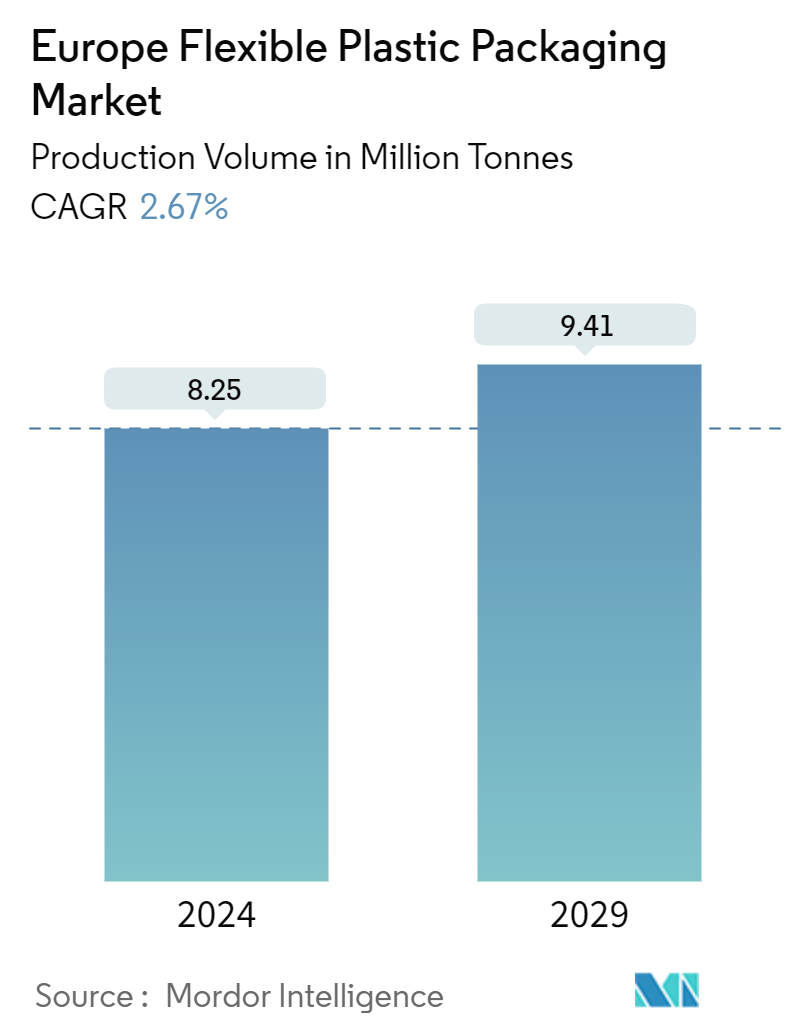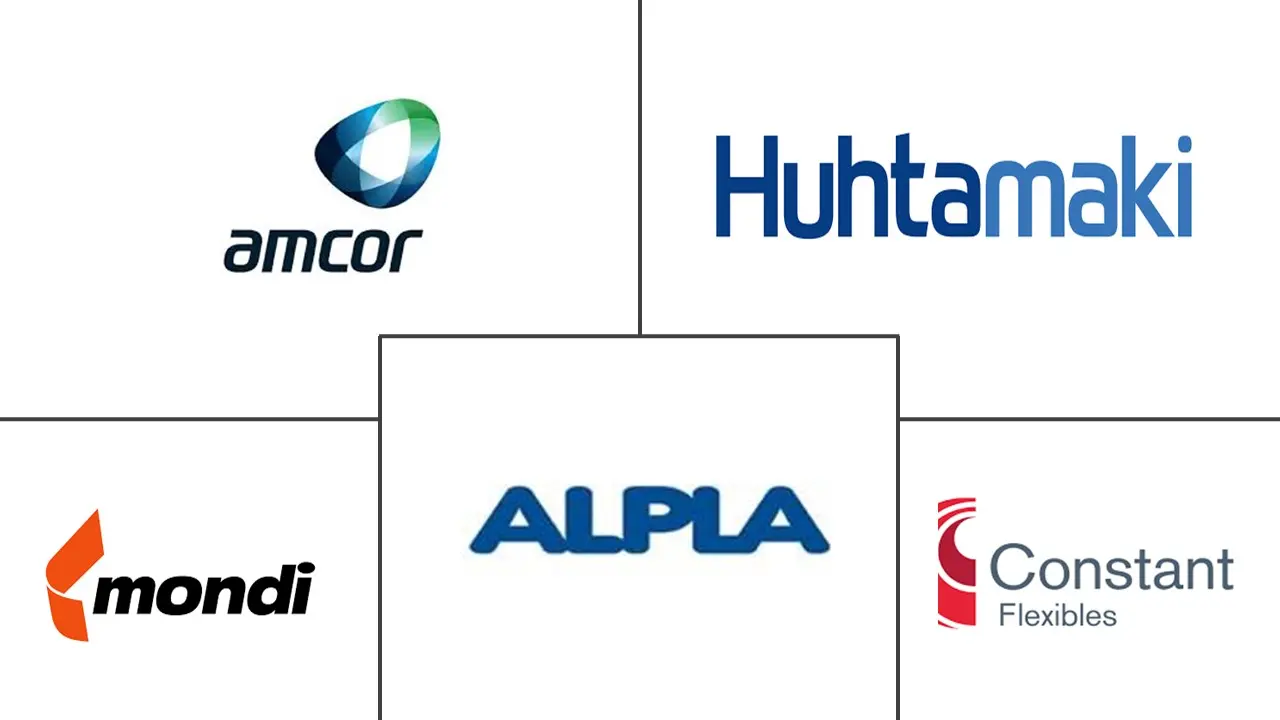Market Size of Europe Flexible Plastic Packaging Industry

| Study Period | 2019 - 2029 |
| Base Year For Estimation | 2023 |
| Forecast Data Period | 2024 - 2029 |
| Historical Data Period | 2019 - 2022 |
| CAGR (2024 - 2029) | 2.67 % |
| Market Concentration | Low |
Major Players
*Disclaimer: Major Players sorted in no particular order |
Europe Flexible Plastic Packaging Market Analysis
The Europe Flexible Plastic Packaging Market size in terms of production volume is expected to grow from 8.25 Million tonnes in 2024 to 9.41 Million tonnes by 2029, at a CAGR of 2.67% during the forecast period (2024-2029).
Europe's flexible plastic packaging market’s growth depends on critical factors, such as a growing emphasis on extending product shelf life, shifting from rigid to flexible packaging, and a rising demand for bioplastics. These trends mirror changing consumer preferences and highlight the industry's increasing focus on sustainability.
- Prioritizing shelf life highlights the industry's commitment to quality and preservation, while the move to flexible packaging emphasizes adaptability and ease. The uptick in flexible bioplastics usage aligns with broader sustainability initiatives, showcasing a clear preference for eco-friendly packaging.
- The flexible plastic packaging industry, which specializes in easily bendable or foldable materials, is witnessing a surge in demand, primarily driven by the need for lightweight and convenient packaging solutions. Manufacturers and converters are at the forefront, constantly innovating to meet these industries' evolving demands.
- The increasing preference for flexible plastic pouches and bags highlights the necessity for adaptable materials and cutting-edge printing techniques. With consumer preferences in flux, manufacturers increasingly emphasize sustainability in materials and processes to stay in tune with market shifts. This strategy is critical to ensuring Europe's packaging industry remains competitive and agile in the face of emerging market needs.
- Plastic has revolutionized the packaging industry, enhancing the shelf life of fresh food, facilitating critical health applications, and promoting lighter, safer shipping while reducing emissions. Its effectiveness as a packaging material stems from its flexibility, strength, lightness, stability, impermeability, and ease of sterilization. With technological advances fueling innovation, flexible plastic packaging increasingly adopts circular practices.
- The market also witnesses challenges concerning restrictions imposed on single-use plastic solutions. In July 2021, the European Union took a firm stance against plastic pollution. Single-use plastic products are prohibited from being sold in EU Member States. This ban extends to food and beverage products made from expanded polystyrene and all items made from oxo-degradable plastic. These single-use plastic products, designed for one-time or short-term use before disposal, are under strict scrutiny and might limit the market’s growth.
Europe Flexible Plastic Packaging Industry Segmentation
The study covers the flexible plastic packaging market in Europe (limited to flexible packaging products made from plastic). The market is tracked in terms of volume (tonnes).
Europe Flexible Plastic Packaging Market Report is Segmented by Material (Polyethene [PE], Bi-Oriented Polypropylene [BOPP], Cast Polypropylene [CPP], Polyvinyl Chloride [PVC], Ethylene Vinyl Alcohol [EVOH], and Other Material Types [Polycarbonate, PHA, PLA, Acrylic, and ABS]), Product Type (Pouches, Bags, Films and Wraps, and Other Product Types), End-User Industry (Food [Frozen Food, Dry Food, Meat, Poultry, and Sea Food, Candy & Confectionery, Pet Food, Dairy Products, Fresh Produce and Other Food (Seasonings & Spices, Spreadables, Sauces, Condiments, etc.)], Beverage, Medical and Pharmaceutical, Personal Care and Household Care, and Other End User Industry [Automotive, Chemical, Agriculture ]), and Country (United Kingdom, Germany, France, Italy, Poland, Spain, Nordic and Rest of Europe). The market sizes and forecasts are provided in terms of volume (tonnes) for all the above segments.
| By Material Type | |
| Polyethene (PE) | |
| Bi-oriented Polypropylene (BOPP) | |
| Cast Polypropylene (CPP) | |
| Polyvinyl Chloride (PVC) | |
| Ethylene Vinyl Alcohol (EVOH) | |
| Other Material Types (Polycarbonate, PHA, PLA, Acrylic, and ABS) |
| By Product Type | |
| Pouches | |
| Bags | |
| Films and Wraps | |
| Other Product Types |
| By End-user Industry | ||||||||||
| ||||||||||
| Beverage | ||||||||||
| Personal Care and Household Care | ||||||||||
| Medical and Pharmaceutical | ||||||||||
| Other End user Industries ( Automotive, Chemical, Agriculture) |
| By Country | |
| United Kingdom | |
| Germany | |
| France | |
| Italy | |
| Poland | |
| Spain | |
| Nordic |
Europe Flexible Plastic Packaging Market Size Summary
The European flexible plastic packaging market is poised for growth, driven by a shift towards more sustainable and adaptable packaging solutions. This transition is fueled by increasing consumer demand for products that extend shelf life and are easier to use, as well as a growing preference for bioplastics. The industry is responding to these trends by prioritizing innovation in materials and processes, aiming to enhance the sustainability and functionality of packaging solutions. The move from rigid to flexible packaging underscores the industry's commitment to meeting evolving consumer preferences and regulatory demands, particularly in the context of the European Union's stringent regulations on single-use plastics.
The market landscape is characterized by a mix of domestic and global players, such as Amcor PLC, Constantia Flexibles, and Mondi PLC, who are actively pursuing strategies like mergers, acquisitions, and product innovations to expand their market presence. The rise of e-commerce and the increasing importance of convenience in packaging are further propelling the demand for flexible plastic solutions. Companies are investing in advanced recycling technologies and sustainable material sourcing to align with the circular economy principles. This focus on sustainability is not only a response to regulatory pressures but also a strategic move to capture the growing market share in the region's dynamic retail and food sectors.
Europe Flexible Plastic Packaging Market Size - Table of Contents
-
1. MARKET INSIGHTS
-
1.1 Market Overview
-
1.2 Industry Attractiveness - Porter's Five Force Analysis
-
1.2.1 Bargaining Power of Suppliers
-
1.2.2 Bargaining Power of Consumers
-
1.2.3 Threat of New Entrants
-
1.2.4 Threat of Substitute Products
-
1.2.5 Intensity of Competitive Rivalry
-
-
1.3 Industry Value Chain Analysis
-
-
2. MARKET SEGMENTATION
-
2.1 By Material Type
-
2.1.1 Polyethene (PE)
-
2.1.2 Bi-oriented Polypropylene (BOPP)
-
2.1.3 Cast Polypropylene (CPP)
-
2.1.4 Polyvinyl Chloride (PVC)
-
2.1.5 Ethylene Vinyl Alcohol (EVOH)
-
2.1.6 Other Material Types (Polycarbonate, PHA, PLA, Acrylic, and ABS)
-
-
2.2 By Product Type
-
2.2.1 Pouches
-
2.2.2 Bags
-
2.2.3 Films and Wraps
-
2.2.4 Other Product Types
-
-
2.3 By End-user Industry
-
2.3.1 Food
-
2.3.1.1 Frozen Food
-
2.3.1.2 Dry Food
-
2.3.1.3 Meat, Poultry, and Seafood
-
2.3.1.4 Candy and Confectionery
-
2.3.1.5 Pet Food
-
2.3.1.6 Dairy Products
-
2.3.1.7 Fresh Produce
-
2.3.1.8 Other Food Products (Seasonings & Spices, Spreadables, Sauces, Condiments, etc.)
-
-
2.3.2 Beverage
-
2.3.3 Personal Care and Household Care
-
2.3.4 Medical and Pharmaceutical
-
2.3.5 Other End user Industries ( Automotive, Chemical, Agriculture)
-
-
2.4 By Country
-
2.4.1 United Kingdom
-
2.4.2 Germany
-
2.4.3 France
-
2.4.4 Italy
-
2.4.5 Poland
-
2.4.6 Spain
-
2.4.7 Nordic
-
-
Europe Flexible Plastic Packaging Market Size FAQs
How big is the Europe Flexible Plastic Packaging Market?
The Europe Flexible Plastic Packaging Market size is expected to reach 8.25 million tonnes in 2024 and grow at a CAGR of 2.67% to reach 9.41 million tonnes by 2029.
What is the current Europe Flexible Plastic Packaging Market size?
In 2024, the Europe Flexible Plastic Packaging Market size is expected to reach 8.25 million tonnes.

